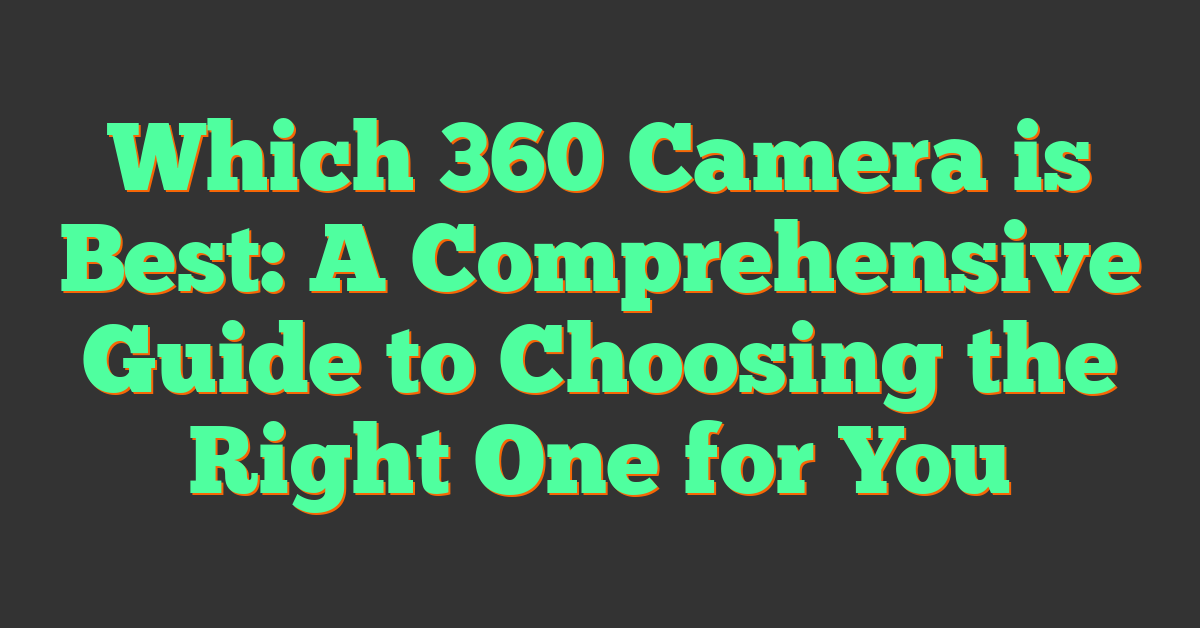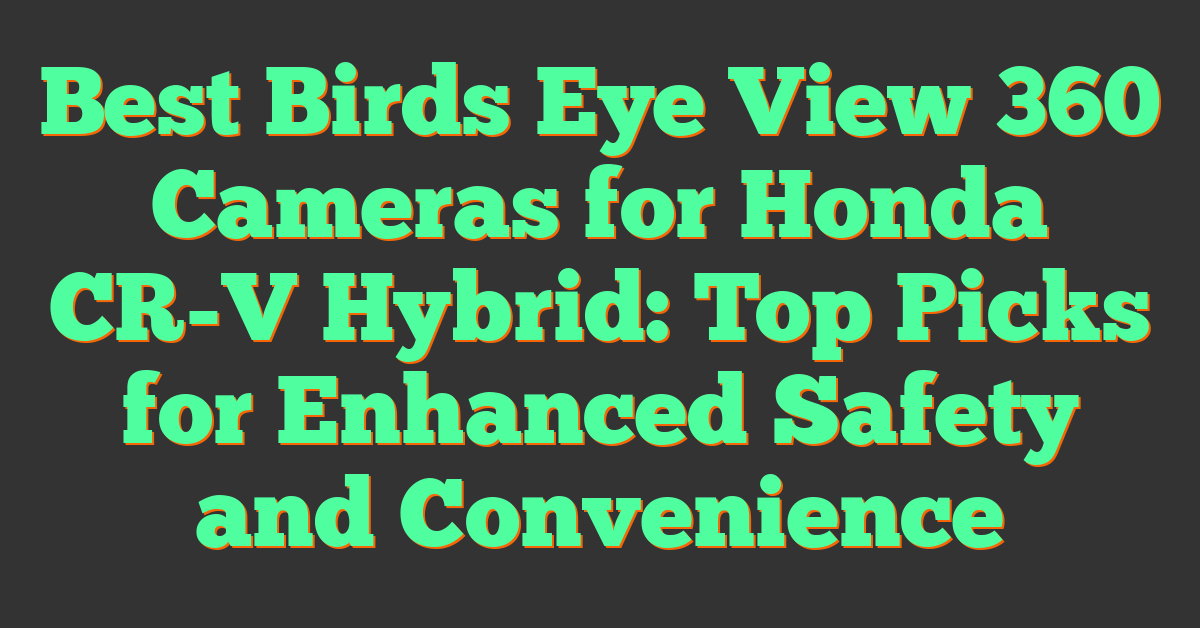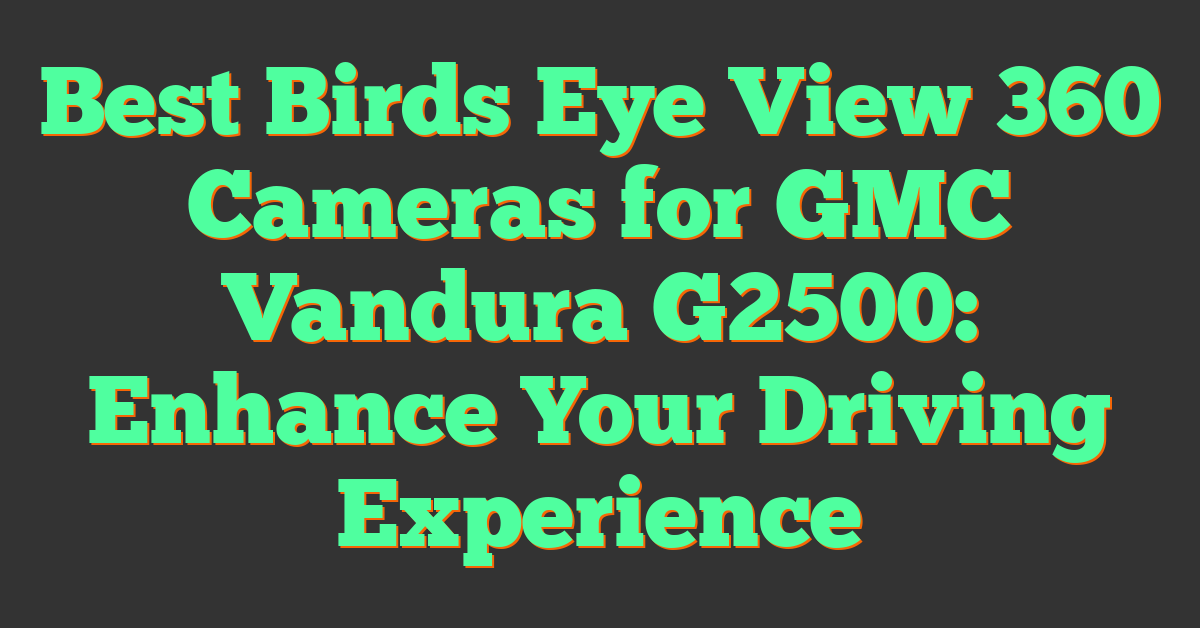If you’re looking to capture the world around you in stunning 360-degree detail, you’ll need a 360 camera. With so many options available, it can be difficult to know which one is right for you. In this article, we’ll explore the top 360 cameras on the market and help you find the perfect one for your needs.

When it comes to choosing a 360 camera, there are a few key features to consider. Resolution is an important factor, as higher resolution cameras will provide clearer and more detailed footage. Another factor to consider is stabilization, which can help keep your footage steady even when you’re moving around. Other important features include battery life, durability, and ease of use.
In the following sections, we’ll take a closer look at the top 360 cameras on the market and explore their key features, pros, and cons. We’ll also provide tips for using your 360 camera and share some creative techniques for getting the most out of your device. By the end of this article, you’ll have all the information you need to choose the best 360 camera for your needs.
Key Takeaways
- When choosing a 360 camera, consider factors like resolution, stabilization, battery life, durability, and ease of use.
- The top 360 cameras on the market include the Insta360 One X2, GoPro Max, and Ricoh Theta Z1.
- With a 360 camera, you can capture stunning footage and explore creative techniques like tiny planet photos and virtual tours.
Understanding 360 Cameras
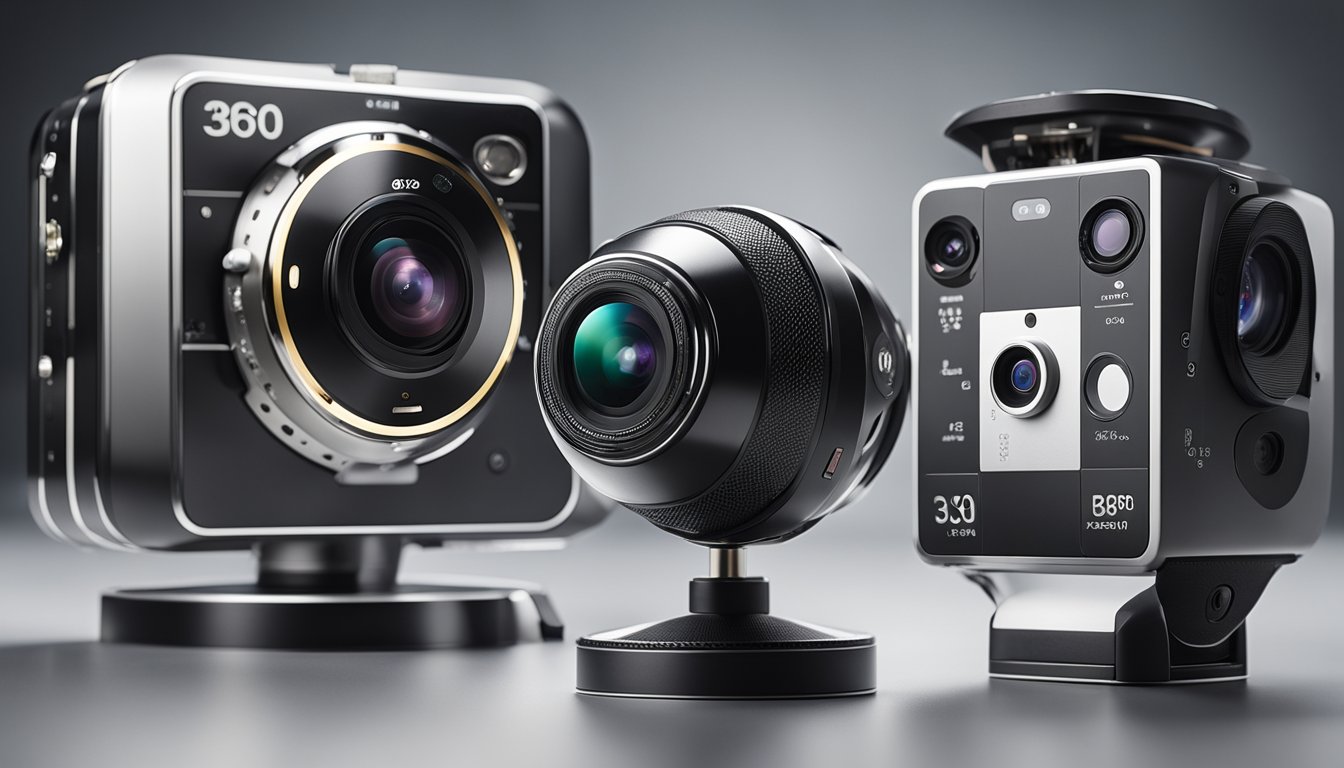
What Is a 360 Camera?
A 360 camera is a specialized camera that captures a 360-degree view of a scene. Unlike traditional cameras, which capture a single perspective, 360 cameras capture everything around them, creating an immersive, spherical view. This means that when you take a photo or video with a 360 camera, you can see everything around you, including above and below.
How 360 Cameras Work
360 cameras work by using multiple lenses to capture a full 360-degree view of a scene. The lenses are arranged in a way that allows them to capture images from every angle, which are then stitched together to create a seamless, spherical view. Some 360 cameras also use software to enhance the final image, such as by removing distortion or adjusting color.
When it comes to video, 360 cameras work by capturing footage from all angles simultaneously. This means that when you watch a 360 video, you can move the camera around in any direction to see different parts of the scene. This creates an immersive experience that makes you feel like you’re actually there.
There are many different types of 360 cameras available, each with its own set of features and capabilities. Some are designed for professionals, while others are more affordable and user-friendly. When choosing a 360 camera, it’s important to consider factors such as resolution, image quality, ease of use, and compatibility with your other devices.
In summary, 360 cameras are a unique type of camera that capture a full 360-degree view of a scene. They work by using multiple lenses to capture images from every angle, which are then stitched together to create a seamless, spherical view. When it comes to video, 360 cameras capture footage from all angles simultaneously, creating an immersive experience that makes you feel like you’re actually there.
Key Features to Consider

When choosing a 360 camera, there are several key features you should consider to ensure you get the best camera for your needs. Below are the most important features to keep in mind:
Resolution and Image Quality
The resolution and image quality of a 360 camera is one of the most important factors to consider. The higher the resolution, the better the quality of the images and videos you will be able to capture. Most 360 cameras on the market today offer at least 4K resolution, but some of the higher-end models can offer up to 8K resolution. Keep in mind that higher resolution also means larger file sizes, so make sure you have enough storage space on your camera or memory card.
Stabilization and Low Light Performance
« What Does a 360 Camera Look Like? A Quick Guide to Its Appearance
Cheap 360 Camera for Motorcycle: Capture Your Rides Without Breaking the Bank »
Another important factor to consider is the stabilization and low light performance of the camera. A good 360 camera should have built-in stabilization to help reduce shaky footage and ensure smooth video. Additionally, look for a camera that performs well in low light conditions. Some cameras have larger sensors or better low light performance than others, which can make a big difference in the quality of your footage.
Durability and Waterproofing
If you plan on taking your 360 camera with you on outdoor adventures, durability and waterproofing are important factors to consider. Look for a camera that is rugged and can withstand bumps and drops. Additionally, some cameras are waterproof or water-resistant, which can be a big advantage if you plan on using your camera near water.
Battery Life and Storage Options
Finally, consider the battery life and storage options of the camera. Some cameras have longer battery life than others, which can be important if you plan on using your camera for extended periods of time. Additionally, look for a camera with ample storage options, such as a built-in memory card or the ability to use external memory cards. This will ensure you have enough storage space for all of your photos and videos.
By considering these key features, you can ensure that you choose the best 360 camera for your needs and capture stunning photos and videos.
Top 360 Camera Picks
https://www.youtube.com/watch?v=9PaEzdPijEI&embed=true
Looking for the best 360 camera on the market? Look no further! We’ve compiled a list of the top 360 cameras that will meet all of your needs. Whether you’re a professional or just starting out, we’ve got you covered.
Best Overall
The Insta360 X3 is our top pick for the best 360 camera overall. With a half-inch sensor, it’s capable of high-quality 5.7K 360-degree video or immersive 72-megapixel 360 photos. It’s versatile and well-rounded, making it a great choice for both beginners and professionals.
If you’re looking for something with more advanced features, the Insta360 ONE RS 1-Inch 360 Edition is a great choice. It has a larger sensor and can shoot up to 5.3K 360-degree video. It also has a built-in GPS and can shoot in RAW format for more advanced editing.
Best for Professionals
If you’re a professional looking for a high-end 360 camera, the GoPro Max is the way to go. It can shoot up to 5.6K 360-degree video and has advanced features like HyperSmooth stabilization and TimeWarp. It’s also waterproof and rugged, making it perfect for outdoor adventures.
For those who need even more advanced features, the Ricoh Theta Z1 is a great choice. It has a larger sensor and can shoot up to 7K 360-degree video. It also has advanced features like manual mode, RAW shooting, and a removable battery.
Best Budget-Friendly Option
If you’re on a tight budget, the Insta360 ONE R is a great choice. It’s affordable and versatile, with the ability to shoot 360-degree video as well as traditional video and photos. It’s also waterproof and has advanced features like Hyperlapse and Bullet Time.
Another great budget-friendly option is the Kandao QooCam 3. It can shoot up to 4K 360-degree video and has advanced features like SuperHDR and a built-in stabilization system. It’s also small and compact, making it easy to take on the go.
No matter what your needs are, there’s a 360 camera out there that’s perfect for you. From the Insta360 X3 to the GoPro Max, there’s a camera that will meet all of your needs and help you capture stunning 360-degree video and photos.
Comparing Popular 360 Camera Brands
https://www.youtube.com/watch?v=DUpnMRs_m00&embed=true
When it comes to 360 cameras, there are a few popular brands that come to mind. In this section, we will compare the most popular 360 camera brands, including GoPro, Insta360, and Ricoh.
GoPro
GoPro is a well-known brand in the action camera market, and they have also entered the 360 camera market with their GoPro Max camera. The GoPro Max camera is a versatile camera that can shoot both 360-degree videos and traditional videos. It has a maximum resolution of 5.6K and can shoot at 30 frames per second. The camera is also waterproof, making it great for outdoor adventures.
Insta360
Insta360 is a brand that is solely dedicated to 360 cameras. They offer a range of cameras, from entry-level to professional-grade cameras. One of their most popular cameras is the Insta360 One R camera. This camera is modular, which means you can swap out the lenses to change the field of view. It also has a maximum resolution of 5.3K and can shoot at 30 frames per second.
Ricoh
Ricoh is another brand that is known for its 360 cameras. They offer a range of cameras, from budget-friendly to professional-grade cameras. One of their most popular cameras is the Ricoh Theta Z1 camera. This camera has a maximum resolution of 23 megapixels and can shoot at 4K resolution. It also has a built-in OLED display and can shoot in raw format.
Overall, each brand has its strengths and weaknesses, and the best camera for you will depend on your specific needs and budget. If you are looking for a versatile camera that can shoot both 360-degree videos and traditional videos, the GoPro Max camera may be the best option for you. If you are looking for a dedicated 360 camera, the Insta360 One R camera is a great option. And if you are looking for a professional-grade camera, the Ricoh Theta Z1 camera may be the best choice.
Exploring Use Cases for 360 Cameras
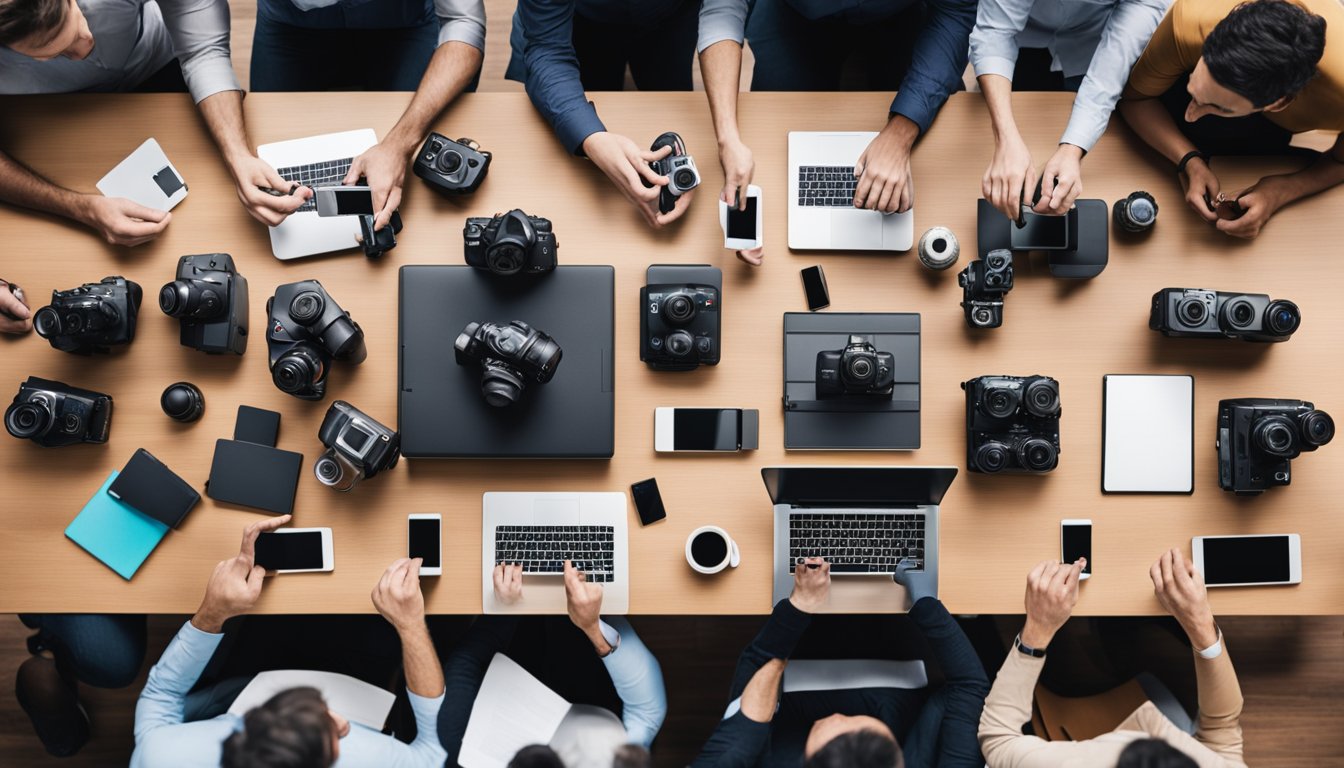
360 cameras are versatile tools that can be used in a variety of settings. Whether you’re an adventure seeker, a real estate agent, or a professional photographer, there is a 360 camera that can meet your needs. In this section, we’ll explore some of the most common use cases for 360 cameras and the features that are important for each.
Adventure and Action Sports
If you’re into adventure and action sports, a 360 camera can help you capture all the action from every angle. Look for a camera that is durable, waterproof, and can capture high-quality video. Some popular options include the GoPro Max and the Insta360 One R. These cameras are designed to withstand extreme conditions and can capture stunning 360-degree footage that will make you feel like you’re right in the middle of the action.
Virtual Tours and Real Estate
360 cameras are also great for creating virtual tours of real estate properties. With a 360 camera, you can capture every corner of a room and create a virtual tour that allows potential buyers to explore the property from the comfort of their own home. Look for a camera that can capture high-quality images and video, and that has features like image stabilization and HDR. Some popular options include the Ricoh Theta Z1 and the Insta360 One X2.
Professional Photography and Videography
For professional photographers and videographers, a 360 camera can be a powerful tool for capturing stunning images and video. Look for a camera that has a high resolution and can capture RAW images for maximum flexibility in post-processing. Some popular options include the Kandao QooCam 8K and the Insta360 Pro 2. These cameras are designed for professional use and can capture high-quality 360-degree footage that is perfect for virtual reality and other immersive experiences.
No matter what your use case is, there is a 360 camera that can meet your needs. Look for a camera that has the features that are important to you, whether that’s action cam durability, virtual tour capabilities, or professional-grade photography and videography. With the right camera, you can capture stunning 360-degree footage that will transport your viewers to another world.
Advancements in 360 Camera Technology
https://www.youtube.com/watch?v=gStdXBJ9cGY&embed=true
360 cameras have come a long way since their introduction. They have evolved to become more versatile and offer advanced features that make them an essential tool for content creators. Here are some of the advancements in 360 camera technology that you should know about.
3D and VR Capabilities
360 cameras have become more sophisticated, and they now support 3D and VR capabilities. With 3D and VR support, you can create immersive content that gives your viewers a more realistic experience. You can capture your surroundings in 3D and let your viewers explore your content in VR. This feature is especially useful for gaming, virtual tours, and other applications that require a more immersive experience.
High-Resolution Video Support
360 cameras have also improved in terms of video quality. The latest cameras can capture video in resolutions up to 8K. This means that you can create high-quality content that looks great on large screens. High-resolution video support is essential for applications such as virtual tours, real estate, and other industries that require high-quality video.
Innovative Software Features
The latest 360 cameras come with innovative software features that make them more user-friendly. For example, some cameras come with apps that allow you to control the camera remotely. You can adjust the settings, preview your shots, and even edit your footage on the go. Some cameras also come with advanced stabilization features that ensure your footage is smooth and stable.
In conclusion, 360 cameras have come a long way in terms of technology. They now offer advanced features such as 3D and VR capabilities, high-resolution video support, and innovative software features that make them more user-friendly. If you are a content creator, a 360 camera is an essential tool that you should consider investing in.
360 Camera Accessories and Mounting Options
https://www.youtube.com/watch?v=SnscHZp7-0k&embed=true
If you are planning to buy a 360 camera, there are a few accessories that you should consider purchasing to enhance your shooting experience. In this section, we will discuss some essential accessories and mounting solutions for different scenarios.
Essential Accessories
Tripod: A tripod is an essential accessory for any 360 camera. It helps to stabilize your camera and ensures that your shots are not shaky or blurry. A tripod is especially useful when shooting in low light conditions or when capturing long exposures.
Action Cams: If you plan to use your 360 camera for action shots, you may want to consider purchasing an action cam. An action cam is a small, mountable camera that can be attached to a helmet, bike, or any other object. It allows you to capture unique and exciting shots that you would not be able to get with a regular 360 camera.
Mounting Solutions for Different Scenarios
Mountable: Most 360 cameras come with a standard tripod mount, which makes it easy to attach them to different types of mounts. You can mount your camera on a car, bike, or any other object that has a flat surface.
Drones: If you want to capture aerial footage with your 360 camera, you can attach it to a drone. There are many drones available that are compatible with 360 cameras. You can use a drone to capture stunning aerial shots of landscapes, events, and more.
In conclusion, there are many accessories and mounting solutions available for 360 cameras. Whether you are shooting action shots, capturing landscapes, or shooting in low light conditions, there is an accessory or mounting solution that can help you get the shot you want.
Creative Techniques with 360 Cameras
https://www.youtube.com/watch?v=Lrqf3kjJyHY&embed=true
If you’re looking for a new way to capture and share your experiences, a 360 camera might be just what you need. These cameras are capable of capturing immersive 360-degree photos and videos, allowing you to relive your favorite moments in a whole new way. But what can you do with all that extra visual information? Here are a few creative techniques you can try with your 360 camera.
Framing and Composition
One of the biggest challenges when shooting with a 360 camera is figuring out how to frame your shots. With so much visual information to work with, it can be difficult to know where to point the camera. One technique you can try is to use the camera’s live view feature to preview your shot before you take it. This will allow you to experiment with different angles and compositions until you find the perfect shot.
Another technique you can try is to use the camera’s overcapture feature. This allows you to capture a full 360-degree image or video, and then choose a smaller section of the image to use as your final shot. This can be a great way to highlight specific details or subjects in your shot, while still capturing the full 360-degree view.
Post-Production and Editing
Once you’ve captured your 360 photos and videos, you can use a variety of post-production and editing techniques to enhance your footage. One popular technique is to use a 360 photo editor to add filters and effects to your images. This can be a great way to add some extra style and flair to your shots.
Another technique you can try is to use a video editing software to create a “tiny planet” effect. This involves taking your 360-degree footage and wrapping it around a sphere, creating a unique and eye-catching visual effect. This can be a great way to add some extra visual interest to your videos.
Overall, there are plenty of creative techniques you can try with your 360 camera. Whether you’re framing your shots using live view, or experimenting with post-production and editing techniques, there’s no shortage of ways to make the most of your camera’s capabilities.
Sharing and Livestreaming with 360 Cameras
https://www.youtube.com/watch?v=OR0o0Jj0YFM&embed=true
Platforms and Audiences
One of the best features of 360 cameras is the ability to share immersive content with your audience. There are several platforms where you can share your 360 content, including YouTube, Facebook, and Vimeo. Each platform has its own unique features and audience, so it’s important to consider your target audience when choosing a platform.
YouTube is the largest video sharing platform and has a large audience of content creators and viewers. It allows for live streaming and has a built-in 360 video player, making it a popular choice for sharing 360 content. Facebook also has a large audience and allows for live streaming, but its 360 video player is not as user-friendly as YouTube’s. Vimeo is a more niche platform that caters to professional filmmakers and videographers, but it has a more polished 360 video player and allows for higher quality uploads.
Setting Up a Livestream
Live streaming with a 360 camera can be a great way to engage with your audience in real-time. To set up a livestream with your 360 camera, you will need a stable internet connection and a compatible streaming platform. Some popular streaming platforms for 360 content include YouTube Live, Facebook Live, and Periscope.
Before you start your livestream, make sure to test your camera and internet connection to ensure that everything is working properly. You may also want to consider using a tripod or stabilizer to keep your camera steady during the stream. It’s also important to engage with your audience during the stream by answering questions and responding to comments in real-time.
In conclusion, sharing and livestreaming with a 360 camera can be a fun and engaging way to connect with your audience. By choosing the right platform and setting up your livestream properly, you can create immersive and interactive content that your viewers will love.
360 Cameras for Different User Levels
https://www.youtube.com/watch?v=uHFf_JCc11Q&embed=true
If you’re looking to buy a 360 camera, there are a lot of options out there. The best camera for you will depend on your skill level and what you plan to use it for. Here are some recommendations for different types of users.
Beginners and Casual Users
If you’re new to 360 cameras, you may want to start with a more affordable and user-friendly option. The Insta360 GO 2 is a great choice for beginners and casual users. It’s small, lightweight, and easy to use. It captures 360-degree video at 1440p resolution and has built-in image stabilization. It’s also versatile, allowing you to capture both standard and 360-degree footage.
Enthusiasts and Semi-Professionals
If you’re more experienced with 360 cameras and want a more solid option, the ONE X2 from Insta360 is a good choice. It has a single-lens design that captures 360-degree footage at up to 5.7K resolution. The camera also has advanced features like FlowState stabilization and TimeShift, which allows you to adjust the speed of your footage. It’s also versatile, allowing you to capture both standard and 360-degree footage.
Another great option for enthusiasts and semi-professionals is the QooCam 8K. This camera has a dual-lens design and captures 360-degree footage at up to 8K resolution. It also has advanced features like SuperSteady stabilization and DepthMap technology, which allows you to adjust the focus of your footage after you’ve shot it.
Industry Professionals
If you’re a professional in the film or photography industry, you’ll want a camera that can handle the demands of your work. The Z1 from Kandao is a great option for industry professionals. It has a dual-lens design and captures 360-degree footage at up to 8K resolution. The camera also has advanced features like real-time stitching and live streaming capabilities. It’s a solid and professional option for those who need the best quality footage.
Overall, there are a lot of great 360 cameras on the market, and the best one for you will depend on your skill level and what you plan to use it for. Whether you’re a beginner or a professional, there’s a camera out there that will meet your needs.
Frequently Asked Questions
https://www.youtube.com/watch?v=5xds4olIjw0&embed=true
What features should I look for in a professional 360 camera?
When looking for a professional 360 camera, you should consider features such as high resolution, image stabilization, and ease of use. A high resolution camera will ensure that your videos and photos are clear and detailed. Image stabilization is important to prevent shaky footage, especially when filming while moving. Ease of use is also important, so you can focus on capturing the moment rather than fiddling with settings.
How do I determine the best 360 video camera for my needs?
The best 360 video camera for your needs depends on how you plan to use it. If you’re a professional videographer, you’ll want a camera with high resolution and advanced features. If you’re a casual user, you may want a camera that’s easy to use and budget-friendly. Consider your needs and budget before making a purchase.
What are the top budget-friendly 360 cameras available?
If you’re on a budget, some of the top budget-friendly 360 cameras available include the Insta360 One X2 and the Ricoh Theta SC2. Both offer high-quality footage and are easy to use, making them great options for casual users.
Which 360 camera is recommended for motorcycle enthusiasts?
For motorcycle enthusiasts, the GoPro Max is a great option. It’s durable and can handle rough terrain, and its HyperSmooth image stabilization ensures that your footage is smooth even on bumpy rides.
Can you suggest a good 360 camera that performs well in low light conditions?
The Insta360 One R is a good option for low light conditions. It has a larger sensor and wider aperture, allowing it to capture more light and produce better quality footage in low light.
What are the advantages of using a GoPro camera for 360-degree videos?
GoPro cameras are known for their durability and versatility, making them a great option for capturing action shots. The GoPro Max also offers advanced features such as HyperSmooth image stabilization and 360 audio, making it a great option for 360-degree videos.

